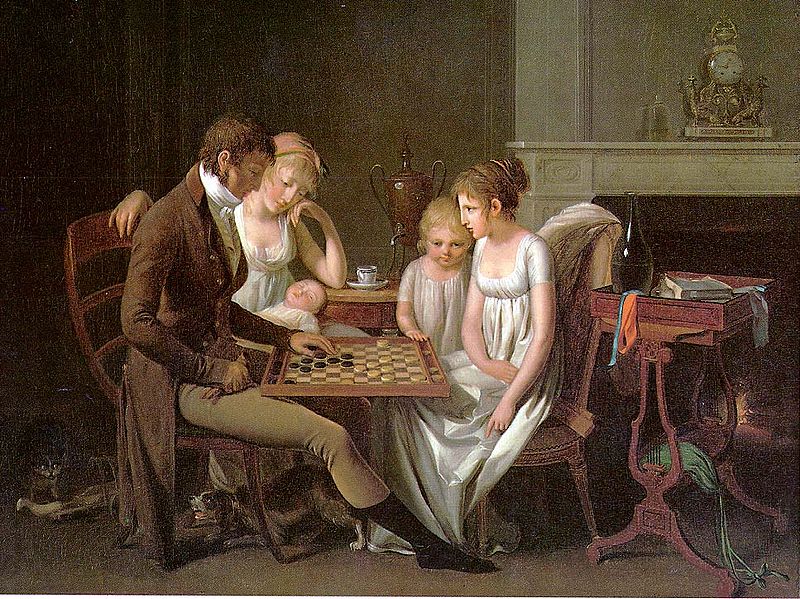The tabletop game renaissance rolls on decades after Settlers of Catan broke through on the American scene. Tabletop games have not displaced video games in the twenty-first century—nowhere near it—but they have reclaimed a surprising place alongside them. My small college town has a thriving game shop. At any given time, several customers can be found browsing its stock of tabletop games, Magic cards, puzzles, D&D manuals, and Warhammer figurines. This always strikes me as remarkable. Other local stores and restaurants are not so fortunate. It is a testament to the owners, who are great people and run a great shop—game nights, summer camps for kids, loyalty programs, rentals, and spot-on recommendations. But it also testifies to the staying power of the renaissance.
This renaissance is usually associated with strategically complex, time-intensive “Eurogames” like Settlers, which remains in the top 20 on Amazon’s game charts as I write this essay, or the more recent Scythe, which was a mania among my friends a few years back. In Scythe, players battle for resource control in an alt-history Europe, part 1920 and part 2120, in which giant mechs menace crop-harvesting peasants and turn over horse-drawn carts. In my experience, Scythe requires several long, puzzled stares at the instruction book(let) to set up. The first time I was invited to play, the host sent me a half-hour YouTube tutorial to watch ahead of time. I was still perplexed when I showed up at his house. I finally started to get the hang of at least some of the resource-hoarding, structure-building, mech-battling intricacies when the game ended after midnight. I finished in last place. Scythe is an absorbing and ultimately rewarding game, but it is a heavy lift for first-timers and a major commitment.
Less commented upon in the tabletop renaissance are games at the other end of the spectrum: smart and family-friendly with a relatively quick playtime. For Christmas two years ago, my daughter gave me a card game titled Zeus on the Loose. It is a fast-paced rollick in which players get a mixed hand of number and “god” cards. As number cards are played, “Mt. Olympus” climbs toward 100. The goal is to have secured the little Zeus figurine when the “summit” is reached. This Zeus is not a particularly awe-inspiring fellow. He does not have the imposing stature, intense gaze, or poised-to-strike readiness of the famous Artemision Bronze. He is a molded-plastic gent with muscles, yes, but also huge feet and one big toe sticking slightly up. He hugs his thunderbolt to him, as if for comfort, and has a slightly bewildered expression—probably because he gets shunted back and forth so much.
You get Zeus whenever you make the card count hit a multiple of ten. You also get him with certain god cards. The gods, in Homeric fashion, wreak havoc on the best-laid plans of human venturers. Lute-strumming Apollo and Artemis, bow in hand and pet bear at her side, let you take the Zeus figure outright. Poseidon tidal waves the card count back by ten and washes plastic Zeus up on your shore. Ares charges onto the battlefield, drives the card count to fifty, and loots the Zeus figurine. Haughty Hera pushes things to the breaking point by changing the card count to ninety-nine. Athena, much to my daughter’s chagrin, is a nearly worthless card. She just allows you to skip the next player. “But she’s the goddess of wisdom and strategery!” I agree. It is a flaw in the game design.
My daughter first played the game at elementary school where it was probably used to practice arithmetic and to teach some rudiments of Greek mythology. Fair enough, I suppose. More importantly, though, its melodramatic reversals of fortune are great fun, and it encourages the right kind of friendly banter between players. We played it with my parents and my sister’s family while visiting them in Pennsylvania. It was a hit with all. My mother, upon whom the gods immediately smiled, would ask with faux innocence, “Oh, did I win, then?” Devastating!
Zeus on the Loose is a welcome addition to our family’s rotation of easy-to-learn games that are good for reunions, after-dinner entertainment for guests, and weeknight fun. Other quick favorites include Sushi Go!, Kingdomino, Lost Cities, and Trash Pandas. I appreciate that these games are welcoming and convivial. It is easy to introduce them to others. Like earlier classics such as UNO, they are good multigenerational games. Grandparents can play them with grandkids, cranky uncles with their nieces and nephews, older siblings with younger. These newer games take some thought—they, too, are usually more complex than the old department store fare—but they also allow for conversation and witty repartee. (Scythe is often too engrossing for much chit-chat or even banter.) They call for shared attention to the game, but they also allow for real attention to one another. They allow for a visit.
This is undoubtedly one reason for the tabletop game renaissance (alongside the obvious but crucial reason that so many of the new games are fun). People are hungry for real-world connection and community. Tabletop games put something in our twitchy, swipe-hungry fingers other than a digital device—a hand of cards, a pair of dice, a plastic Zeus. And since others have put down their phones too, we can look out over those cards into a human face, a present human face.
This sense of gathered presence is something we are particularly hungry for these days. Gorging on the digital leaves one starved for presence. The philosopher and literature scholar Hans Ulrich Gumbrecht argues that this kind of presence—the experienced proximity of embodied creatures and tangible things in a concrete place—receives scant positive attention, and a fair amount of skeptical scrutiny, from thinkers over the course of modernity. Yet it is something that we all experience, and it is something for which we do hunger. Gumbrecht argues that our increasingly digital existence allows us to be anywhere (nowhere?) at any given time. It draws us away from a bounded tangible reality into a seemingly infinite digital or virtual reality. In doing so, it draws us away from this kind of embodied presence. If we become “hardwired in” as cyborgs, we may eventually obliterate such presence altogether. Yet, at the same time, digital dissatisfaction can stoke the hunger for real-world connection. It can help us become more consciously aware of it and not take it for granted. Gumbrecht thus nods to Heidegger’s nod to Hölderlin’s famous lines in his poem “Patmos”: “But where danger threatens / That which saves from it also grows.” Or, in Gumbrecht’s digital-age adaptation of these lines in his 2004 book Production of Presence, “the more we approach the fulfillment of our dreams of omnipresence and the more definite the subsequent loss of our bodies and of the spatial dimension in our existence seems to be, the greater the possibility becomes of reigniting the desire that attracts us to the things of the world and wraps us into their space.”
This hunger for presence may help to explain the tabletop renaissance and other countervailing tendencies in the digital age: the widespread dissatisfaction with digital classrooms during the pandemic, the persistence of physical books alongside eBooks, the attendant comeback of both independent and big box bookstores, the steady staying power of farmers markets and slow food, the renewed interest in more human-scale and neighborhood-based urban design, perhaps as well the seeming flop of the much-hyped metaverse.
The recently deceased Albert Borgmann, in a series of books from the mid-80s to the mid-2000s, stresses the need for “focal things” and “focal practices” in an increasingly technological society. “Focal things” draw us to them and draw us into the moment. They engage us in rich, enlivening “focal practices.” In all these ways they make us present and attuned to presence. Borgmann uses the dinner table as his chief example of a focal thing with the shared meal as its attendant focal practice. Like Gumbrecht, Borgmann makes the hopeful claim that our alienating devices not only threaten focal things and practices but also clarify our need for them and deepen our appreciation of them via contrast. Tabletop games are focal things that help keep us gathered as family and friends around Borgmann’s paradigmatic dinner table rather than dispersing each to our own devices. In this regard, the tabletop renaissance is not only fun but existentially and socially salutary. The gods of the tabletop, even those more awe-inspiring than my small plastic Zeus, will not save us in our direst need. But they can help.
Image credit: Wikimedia Commons






7 comments
Kentucky Squirrel
This was a wonderful read! If you’re looking for a new RPG, might I recommend “Amboria: Roleplaying in the World Under Starlight”: https://amboria.backerkit.com/hosted_preorders
Currently up for preorder, the game is unique in that all of the lore is based on epic poetry written by the author, Richard Rohlin, and incorporates an actual liturgical cycle!
Rob G
I’ve found it encouraging that in the past few years there seems to have been a surge in popularity in chess among young men in their late teens through the 30-somethings. Quite a few younger guys that I know play it regularly, both in person and on line. A local barber shop that caters to younger men even has a chess club.
Steven Knepper
That is indeed encouraging! Sounds like a great barber shop too!
Brian D Miller
Just the piece I needed to read as winter starts to get a bite. Thanks for the suggestions. But, what, no Mind?
Steven Knepper
Thanks for reading! Yes–winter’s finally here in the Shenandoah Valley as well. At the risk of being obtuse, is Mind a game I should know about? We’re always looking for suggestions ourselves. Best wishes, Steve
Brian D Miller
He asks in all seriousness, “is The Mind a game I should know about?”
Yes, sir. I could explain how to play in 30 seconds. But that would ruin all the fun. Easy to find at most stores that carry games.
Enjoy (and thanks for the new tips),
Brian
Steven Knepper
I’m on it! Thanks again, Brian.
Comments are closed.